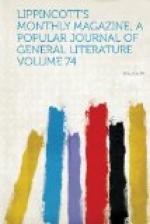Till at length one Sabbath morning—deep-voiced
church-bells shook the air—
While in festal garb the church-folk wandered to
their house of prayer,
Reached their ears a hollow thunder from the glaciers
overhead,
And huge blocks of ice came crashing downward to
the river’s bed,
And in silence,
Wrathful silence,
Down the seething stream they sped.
Ah, the breathless hush that followed!
for amid the icy waste
They a human shape discerned, madly, as by demons
chased,
Up the crystal ledges climbing, pausing now where
ice-walls screen
From the blast, then upward springing o’er
abyss and dread ravine,
Until silence,
Glittering silence,
Reigned amid the icebergs’ sheen.
They have searched for him, they
told me, sought him far and sought him near:
Ne’er a trace was found to tell them of his
grave so lone and drear;
But the legend goes that angels swift the shining
ether clove,
And with them his youth’s beloved bore him
up to God above,
Where shall silence,
Deepest silence,
Never sunder hearts that love.
HJALMAR HJARTH BOYESEN.
[Footnote 1: The Hulder is the spirit of the forest, and is represented as a virgin of wonderful beauty. She plays her loor, a long birch-bark horn, at evening, and is the protecting genius of the cattle.]
THACKERAY’S “GRAY FRIARS.”
There is an eloquent passage in one of Victor Hugo’s novels in which the writer affectionately apostrophizes the Paris of his youth—those quaint old streets of the Quartier Latin so redolent of the happy associations which cling to the springtide of life. Were Thackeray living now, he would, we fancy, experience emotions very similar to those of his French confrere should he try to find his beloved “Gray Friars,” which lives enshrined in the most pathetic scene he ever penned, and is ever and anon coming before us in the pages of his several stories. It is but a few years since the author of Vanity Fair passed away, yet already Gray Friars’ surroundings are no longer those with which he was familiar.
Descending Holborn Hill five years ago, you found yourself, when at the foot of that celebrated thoroughfare, at Snow Hill, just at that point where the words, “Here he is, father!” struck upon the parental ears of Mr. Squeers as his son and heir manfully “went for” Smike. Turning to the left, instead of proceeding up Newgate street, a circuitous street took you to Smithfield, so long associated with stakes and steaks. Thence, when half-way through the forest of pens, you turned sharp off to the left, and then, after another hundred yards by a turn to the right, found yourself in a long narrow lane, called Charter-House lane. This brought you presently to some iron gates admitting you to a quaint and not very mathematical quadrangle, such as you would never have dreamed of stumbling upon there. This is




